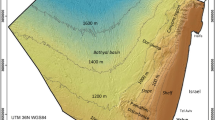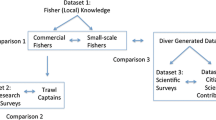Abstract
The 2010 Gulf of Mexico oil spill was the largest in history outside of warfare and because the spill occurred in the deep sea, its impact on the biota will be difficult to assess. To help address this problem we have created SpeciesMap (http://speciesmap.org), a web-based application (web app) that allows a user to synthesize data on the oil spill with distributional records and other information on marine species. We have combined satellite image data collected over the course of the oil spill with locality data from historical collection records of fish species in a geographic information system. In doing so, we have created maps to assess which species were potentially in the region of the spill and to what degree their range was exposed to pollution. To evaluate the impact of the spill, we examined and categorized various levels of overlap between the observed surface range of the 2010 spill with collections records for 124 fish species including all 77 endemic to the Gulf of Mexico. More than half of all species examined (including more than half of all endemics) were found to have population records in the region of the spill. SpeciesMap contains interaction maps for all the species examined and these data can be used to target post-spill collections, to evaluate changes in habitat, and to discover extirpations or extinctions in response to environmental disturbances.

Similar content being viewed by others
References
Campagna C, Short FT, Polidoro BA, McManus R, Collette BB, Pilcher NJ, de Mitcheson YS, Stuart SN, Carpenter KE (2011) Gulf of Mexico oil blowout increases risk to globally threatened species. Bioscience 61:393–397
Collette BB et al (2011) High value and long life-double jeopardy for tunas and billfishes. Science 333:291–292
Deepwater Horizon Unified Command (2010) U.S. scientific teams refine estimates of oil flow from BP’s well prior to capping. http://www.deepwaterhorizonresponse.com/go/doc/2931/840475/. Accessed 2 Aug 2011
Fodrie FJ, Heck KL Jr (2011) Response of coastal fishes to the Gulf of Mexico oil disaster. PLoS ONE 6:e21609
Froese R, Pauly D (2000) FishBase 2000: concepts, design and data sources. ICLARM. Los Baños, Laguna, p 344
Gaskill M (2010) What will get sick from the slick? Nature 466:14–15
Ho HC, Chakrabarty P, Sparks JS (2010) Review of the Halieutichthys aculeatus species complex (Lophiiformes: Ogcocephalidae) with descriptions of two new species. J Fish Biol 77:841–869
Hoese HD, Moore RH (1998) Fishes of the Gulf of Mexico, Texas, Louisiana and Adjacent Waters, 2nd edn. Texas A&M University Press, College Station, p 422
IUCN (2011) Red list assessment of Gulf of Mexico Endemic Marine Fishes. Harte Research Institute, Texas A&M University, Corpus Christi, pp 1–6. www.sgmsummit.org. Accessed 11 Nov 2011
Jernelöv A (2010) How to defend against future oil spills. Nature 466:182–183
Mascarelli A (2010) Debate grows over impact of dispersed oil. Nat News. http://www.nature.com/news/2010/100710/full/news.2010.347.html. Accessed 4 Oct 2011
McEachran JD (2009) Fishes (Vertebrata: Pisces) of the Gulf of Mexico. In: Felder DL, Camp DK (eds) Gulf of Mexico origin, waters, and biota, vol I., BiodiversityHarte Research Institute, Corpus Christi, pp 1223–1316
Orcutt B, Joye S, Kleindienst S, Knittel K, Ramette A, Reitz A, Samarkin V, Treude T, Boetius A (2010) Impact of natural oil and higher hydrocarbons on microbial diversity, distribution, and activity in Gulf of Mexico cold-seep sediments. Deep Sea Res II 57:2008–2021
Safina C (2011) The 2010 Gulf of Mexico oil well blowout: a little hindsight. PLoS Biol 9:e1001049
Schrope M (2010) Oil cruise finds deep-sea plume. Nature 465:274–275
Stockstad E (2010) Hunting for plumes, learning to live in a media spotlight. Science 329:22–23
Whitehead A, Dubansky B, Bodinier C, Garcia TI, Miles S, Pilley C, Raghunathan V, Roach JL, Walker N, Walter RB, Rice CD, Galvez F (2011) Genomic and physiological footprint of the Deepwater Horizon oil spill on resident marsh fishes. PNAS 108:6193–6198
Acknowledgments
We would like to thank the participants of the International Union for the Conservation of Nature (IUCN) Red-List workshop for Gulf of Mexico Endemic Marine Fishes for many discussion about the oil spill and its effects on Gulf fishes. We would particularly like to thank Beth Polidoro, Heather Harwell, Bruce Collette, John Caruso, Frank Pezold, Luke Tornabene, Becky Allee, Jorge Brenner, John Carlson, Dean Grubbs, John McEachran, James Simons, and Ross Robertson for their valuable input. This work was supported by National Science Foundation grant 0916695 to PC.
Author information
Authors and Affiliations
Corresponding author
Rights and permissions
About this article
Cite this article
Chakrabarty, P., Lam, C., Hardman, J. et al. SpeciesMap: a web-based application for visualizing the overlap of distributions and pollution events, with a list of fishes put at risk by the 2010 Gulf of Mexico oil spill. Biodivers Conserv 21, 1865–1876 (2012). https://doi.org/10.1007/s10531-012-0284-4
Received:
Accepted:
Published:
Issue Date:
DOI: https://doi.org/10.1007/s10531-012-0284-4




